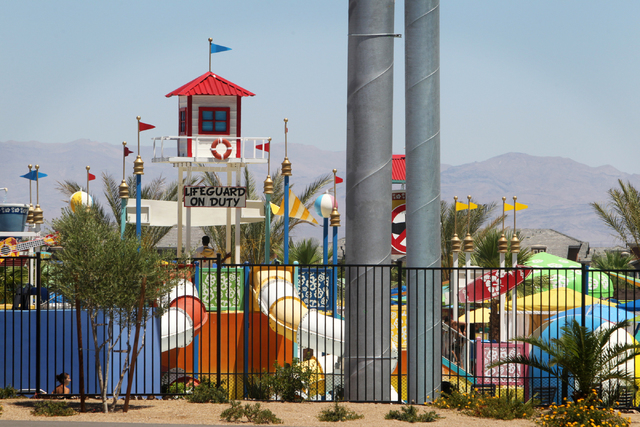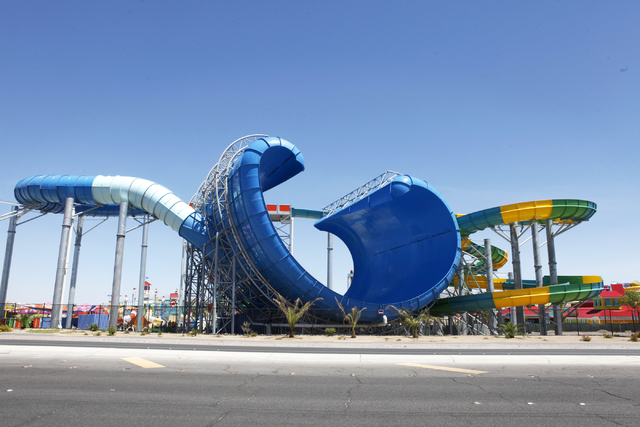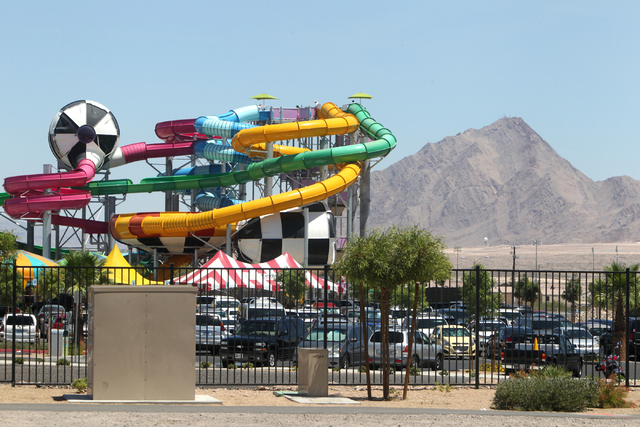Cowabunga Bay fined for lifeguard numbers after near drowning
Just days after a 5-year-old boy nearly drowned at Cowabunga Bay in May, the Southern Nevada Health District cited the Henderson water park for failing to meet safety requirements, including not having enough lifeguards on duty.
Documents obtained by the Las Vegas Review-Journal show the health district received a complaint regarding Cowabunga Bay’s lifeguard coverage the day after the May 27 near-drowning.
On May 28, the district investigated the complaint and found multiple safety violations.
The health district report dated May 29 and signed by Cowabunga Bay General Manager Shane Huish shows Cowabunga Bay also lacked proper water safety signage, including emergency procedure signs and “No Diving” signs as required by state law.
But regulatory problems didn’t stop in May. The health district returned June 9 for a regularly scheduled annual inspection, finding only eight of the required 17 lifeguards working.
The health district hit Cowabunga Bay with a $118 fine, warned that “failure to maintain adequate coverage could result in closure with fees,” and gave Cowabunga Bay 30 days to correct the violations.
Huish and the Cowabunga Bay public relations office declined comment for this article. But in a statement released the day of the near-drowning, Huish praised lifeguard response.
“I am extremely proud of our staff and how quickly they responded to the situation,” Huish said. “Right now our concern is with the health and well-being of those involved.”
TRAINING TECHNIQUES QUESTIONED
Cowabunga Bay’s lifeguards are trained by the National Aquatic Safety Co., a Houston-based agency that uses an in-water lifesaving technique often referred to as the Heimlich maneuver.
At least one other state has required NASCO to remove the Heimlich maneuver, also known as abdominal thrusts, from its training manuals.
There’s no indication that’s happened in Nevada.
In a letter addressed to John Hunsucker, the president of NASCO, the State of New Jersey Department of Health said some of the company’s training techniques — specifically the “in-water-intervention protocol,” which specifies the use of abdominal thrusts on an unconscious drowning victim — were recently found to be scientifically baseless.
The New Jersey health department withdrew recognition of NASCO’s lifeguard training course until it issued a “NASCO New Jersey Textbook” without the technique, according to the letter.
“After they provided a NJ specific Lifeguard Training Manual, we reinstated recognition of their certification for NJ lifeguards,” Timothy Smith, acting program manager for the New Jersey Department of Health, wrote in an email.
But NASCO’s main “Lifeguard Textbook,” revised in 2014 and shown on its website, still contains the in-water-intervention protocol.
There’s no indication in public records that the Heimlich maneuver was used the day the 5-year-old boy nearly drowned.
A Henderson police report form shows lifeguards used CPR to save his life.
The boy was found in the deep end of the wave pool, according to the police report. The lifeguard first shouted to a nearby woman, who “looked down at the submerged juvenile in shock.”
The lifeguard “sounded his whistle and dove in to contact the juvenile,” and pull him to safety. CPR was administered on an upper deck until paramedics arrived.
The child was taken to St. Rose Dominican Hospital — Siena Campus.
It’s unclear how long the boy was under water or what his current condition is. He has not been publicly identified.
NO TO ABDOMINAL THRUSTS
NASCO has declined to comment but a post on its website, “An Open Letter to Our Clients, The Public and The Press” states that the company is being attacked over its techniques “by others whose technology and protocols lag significantly behind ours …”
A lifeguard supervisor at Cowabunga Bay, who was present during the near drowning on May 27 but did not want to be named in this story, told the Review-Journal that part of her training involves learning how to use abdominal thrusts on both alert and unconscious drowning victims.
All Las Vegas city pools have Red Cross certified lifeguards, according to a spokesperson.
Wet ’n’ Wild Director of Operations Rick Bulhumeur said the water park’s lifeguards are trained by Jeff Ellis & Associates, a company that conducts three comprehensive unannounced, undercover audits throughout the summer. He said he doesn’t believe using abdominal thrusts in the water is necessary.
Both the American Red Cross and the American Heart Association no longer recommend the use of the abdominal thrusts as a way to rescue a drowning victim, saying research has disproven its usefulness.
The 2010 American Heart Association guidelines for Cardiopulmonary Resuscitation and Emergency Cardiovascular Care, which are updated every five years, states that using abdominal thrusts to remove water from the breathing passages is considered “unnecessary and potentially dangerous.”
Experts instead recommend using CPR, a combination of chest compressions and rescue breaths.
“Our science is grounded on CPR and the fact that the Heimlich maneuver is supposedly dangerous,” said Jennifer Merback, a spokesperson for the American Heart Association Las Vegas Division. “We never want to put someone’s life in danger.”
Merback said the American Heart Association has discouraged the use of abdominal thrusts as the first step to resuscitate submersion victims since as early as 2000.
“(That year) is when we really clarified that it’s not evidence-based,” she said. “Everything is focused on the science and the research for it to be backed by the AHA.”
Those few minutes between when the lifeguards blow their whistle and arrival of paramedics are crucial, said American Red Cross Aquatic Safety Specialist Max Goshert. Using the Heimlich maneuver on a drowning victim is not in the Red Cross’ emergency procedure.
“If you pulled someone from the water, it wouldn’t provide any help,” Goshert said. “The thing that’s killing you when you’re drowning is the lack of oxygen, not the water in your lungs.”
Dr. Kreg Burnette, a pediatrics emergency physician at the children’s hospital of Nevada’s University Medical Center said the main goal to help a drowning victim is “to get them breathing again.”
“You want to get air into the lungs,” he said. “The Heimlich maneuver isn’t really going to do that. The whole idea of the Heimlich is to increase pressure to help push objects, not liquids, out of the airways or esophagus. It will not empty water out of the lungs.”
Performing the Heimlich on a drowning victim could complicate things further, Burnette said.
“If you induce someone to vomit, it will not affect anything that has gone down to the lungs,” he said. “If they are breathing or gasping for air, they can take that vomit into their lungs, which could make it even worse.”
According to Nevada Administrative Code 444.274, a lifeguard must have “satisfactorily completed a Red Cross Advanced Lifesaving Course or the equivalent.”
Jeremy Harper, the environmental health supervisor for the aquatic health program at the health district, said the health district “does not regulate the content of the (lifeguard) course.”
Contact Review-Journal writer Michelle Iracheta at 702-387-5205. Follow @cephira on Twitter.
































